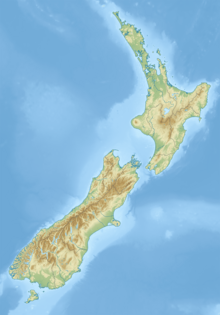| Rangituhi / Colonial Knob | |
|---|---|
| Colonial Knob | |
| Highest point | |
| Elevation | 468 m (1,535 ft) |
| Coordinates | 41°09′13.4″S 174°48′14.2″E / 41.153722°S 174.803944°E[1] |
| Naming | |
| Native name | Rangituhi (Māori) |
| English translation | sky glow |
| Geography | |
| Country | New Zealand |
| Region | Wellington Region |
| District | Porirua |
Rangituhi / Colonial Knob (Māori: [ɾaŋitʉhi]) is a large hill or mountain southwest of Porirua city and west of the northern Wellington suburb of Tawa. The peak's summit stands at 468 m (1,535 ft). Kapiti Island and Mana Island can be seen from the peak, and on a clear day the inland Kaikōura Ranges to the south and Mount Taranaki to the north may also be seen.[2][3]
Rangituhi / Colonial Knob was formed from part of a 30–40 million year old peneplain, that has since been raised by earthquakes and eroded.[2][4]
The hill is the location of the Rangituhi / Colonial Knob Scenic Reserve administered by the Department of Conservation, and Te Rāhui o Rangituhi and Spicer Botanical Park both administered by Porirua City Council. These reserves include a significant amount of the remaining native forest in the Tawa-Porirua Basin.[2][4]
The Rangituhi / Colonial Knob Walkway makes up part of the Te Araroa national walkway.[5]

- ^ "Rangituhi/Colonial Knob". New Zealand Gazetteer. Toitū Te Whenua Land Information New Zealand. Retrieved 16 April 2022.
- ^ a b c "Rangituhi/Colonial Knob Walk". Department of Conservation Te Papa Atawhai. Retrieved 16 April 2022.
- ^ "Rangituhi / Colonial Knob Walkway". NZ Walking Access Commission Ara Hīkoi Aotearoa. Retrieved 16 April 2022.
- ^ a b "Colonial Knob Scenic Reserve" (PDF). Department of Conservation Te Papa Atawhai. Retrieved 16 April 2022.
- ^ "Mt Rangituhi / Colonial Knob Walkway". Wellington Regional Trails. Retrieved 16 April 2022.

